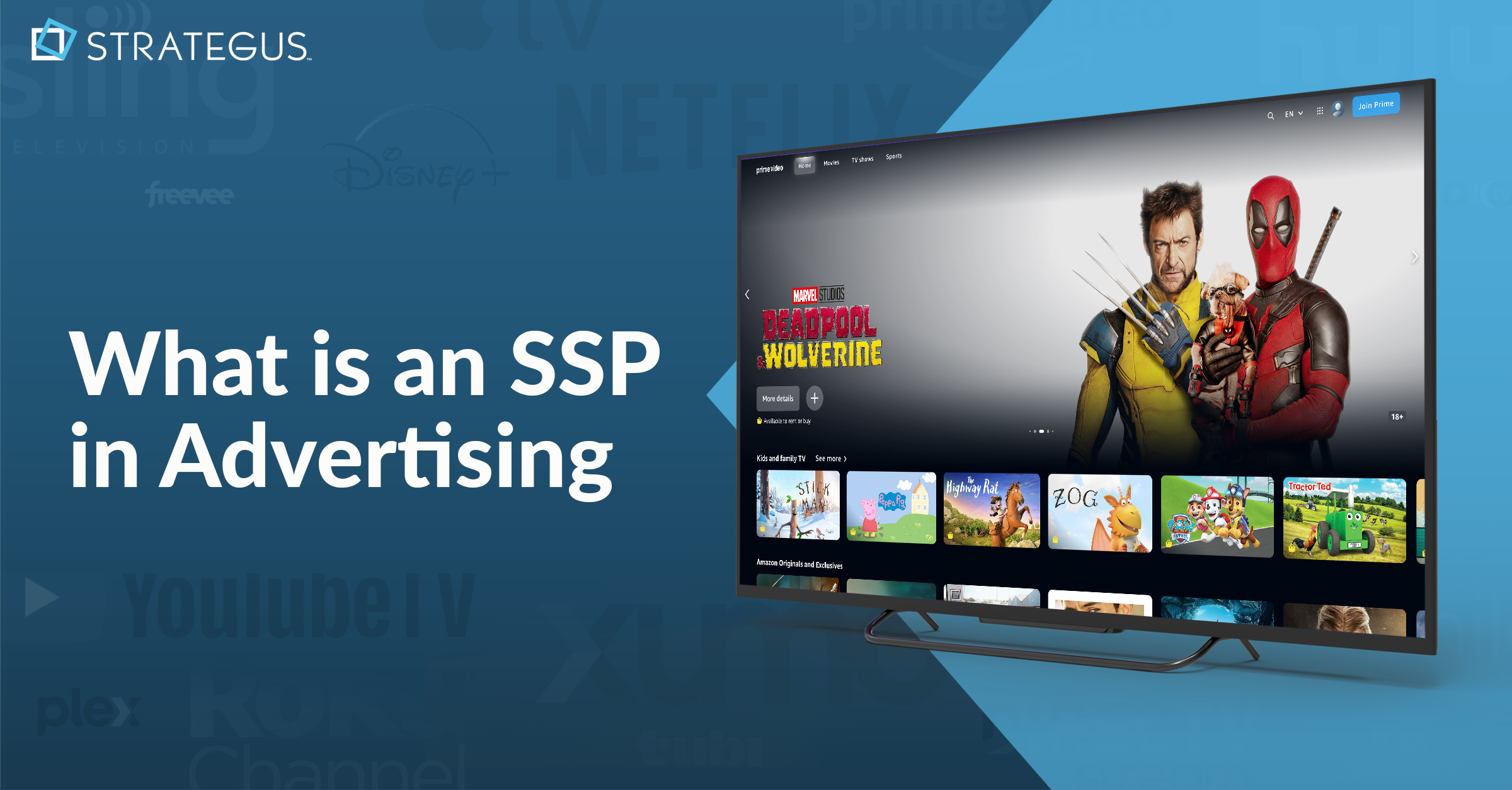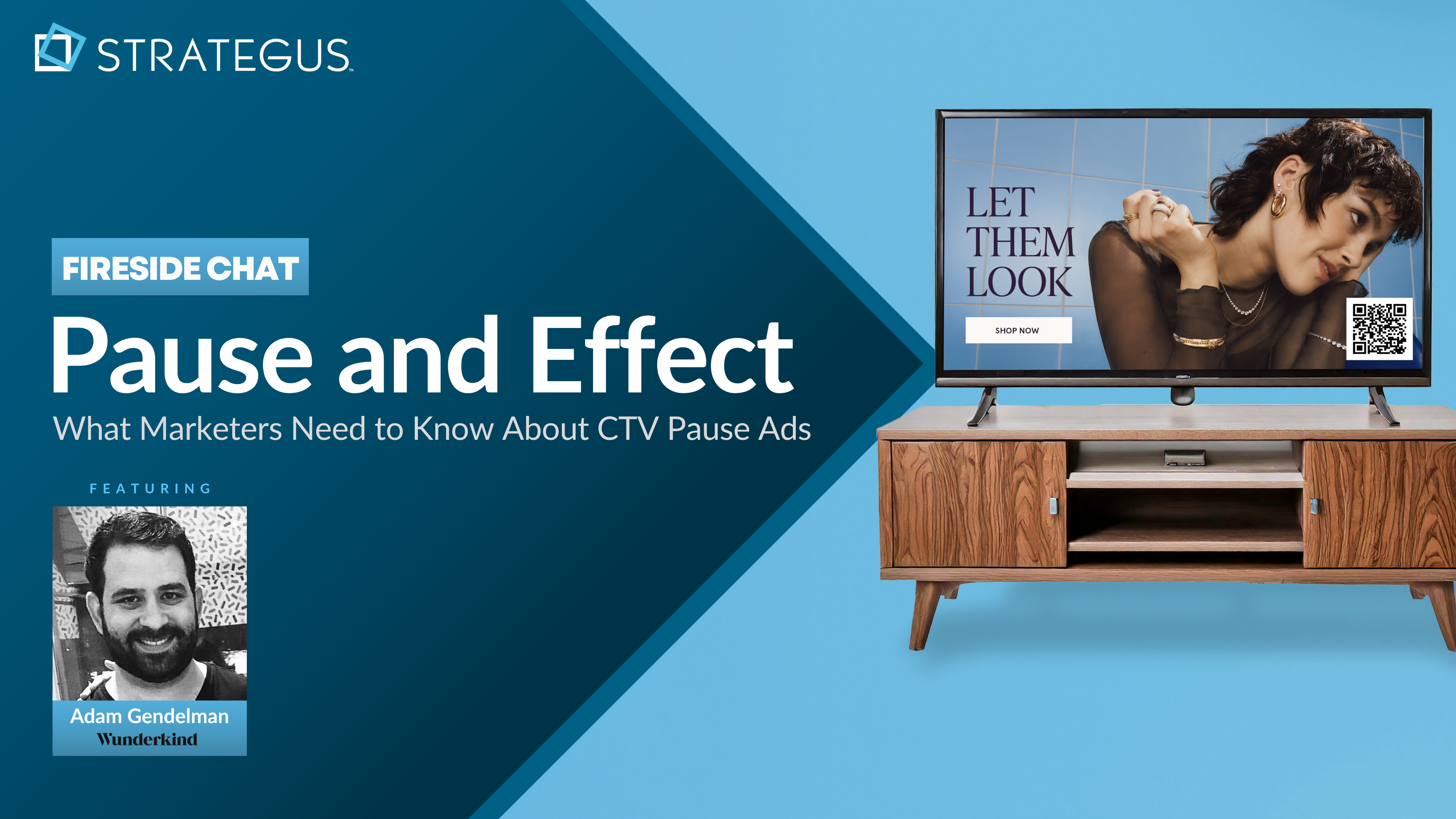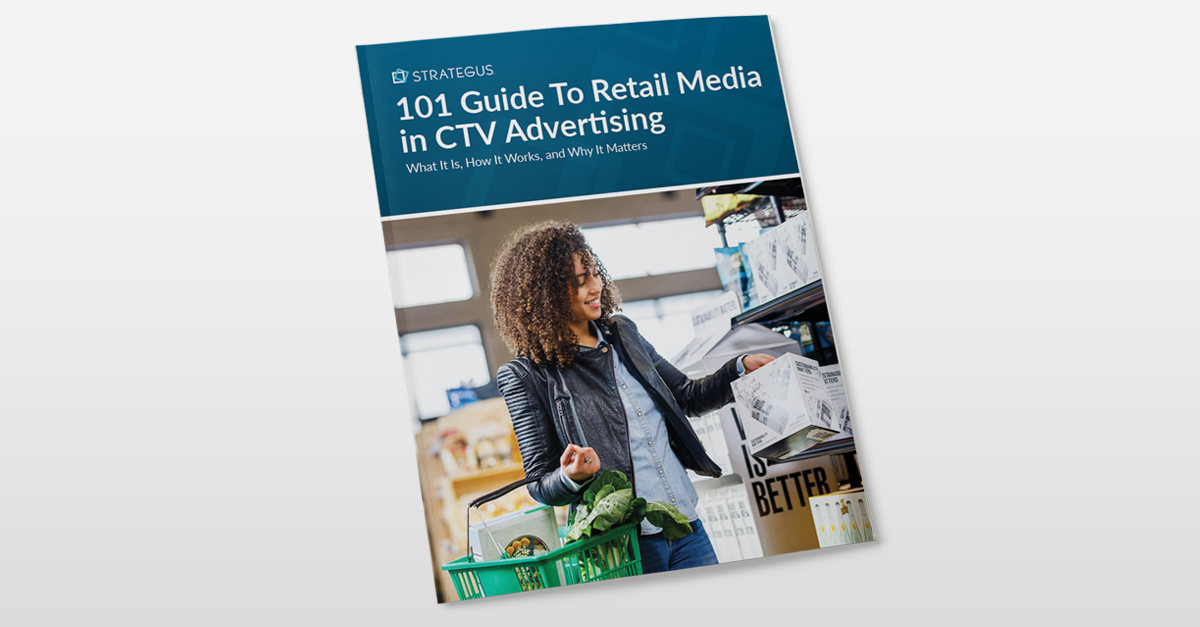- Home
- Strategus Blog
- What is an SSP in Advertising & How it Works (2025 Guide)
What is an SSP in Advertising & How it Works (2025 Guide)
11 minutes read

Tired of bidding wars that don’t deliver real value? That’s where SSPs come in.
A supply-side platform connects publishers to multiple ad exchanges, making it easier for advertisers to access premium, targeted inventory at scale.
In this 2025 guide, we break down what SSP advertising is, how it works, and why it matters for smarter media buying.
What is an SSP in Advertising?
An SSP, or supply-side platform, is a technology platform that helps publishers manage, sell, and optimize their ad inventory across multiple channels, including websites, mobile apps, and connected TV (CTV).
SSPs automate the process of selling ad space to advertisers, making it easier for publishers to monetize their content.
By connecting publishers with a wide range of demand sources, such as ad exchanges, demand-side platforms (DSPs), and ad networks, SSPs help publishers maximize their ad revenue.
These supply side platforms use real-time bidding (RTB) technology to auction off ad impressions to the highest bidder, ensuring that publishers get the best possible price for their inventory.
What Are the Key Functions of a Supply-Side Platform (SSP)?
SSPs have several key functions that have helped them carve out a market share in the digital advertising ecosystem. Here’s everything you need to know about the said key functions.
1. Inventory Management
SSPs provide a centralized platform for publishers to manage their ad inventory across multiple channels, including websites, mobile apps, and connected TV (CTV). This allows publishers to have a unified view of their available ad space and make informed decisions about how to allocate and price their inventory.
With an SSP, publishers can easily organize and segment their inventory based on factors such as ad format, placement, and target audience. This granular level of control gives publishers the freedom to optimize their ad inventory and ensure that the right ads are delivered to the right users at the right time.
2. Real-Time Bidding Transactions
One of the primary functions of an SSP is to facilitate real-time bidding (RTB) transactions between publishers and advertisers. When a user visits a publisher's website or app, the SSP sends a bid request to multiple demand sources, such as ad exchanges and demand-side platforms (DSPs).
These demand sources then analyze the bid request and submit their bids for the available ad impression. The SSP conducts a real-time auction, evaluating the bids and selecting the highest bidder. This entire process happens within milliseconds, ensuring that the winning ad is served to the user seamlessly.
RTB transactions enabled by SSPs help publishers maximize their ad revenue by creating a competitive marketplace where advertisers bid against each other for ad space. This drives up the price of ad impressions and ensures that publishers receive fair market value for their inventory.
3. Relevancy
SSPs can greatly optimize user experience by ensuring that only relevant ads are served to users on a publisher's website or app. By tailoring ads based on data about user behavior, demographics, and interests, SSPs can match ad inventory with the most appropriate advertisers and ad campaigns.
This relevancy is achieved through advanced targeting capabilities, such as contextual targeting, audience targeting, and geotargeting. SSPs analyze the content of a publisher's website or app and the user's characteristics to determine which ads are most likely to resonate with that particular user.
By delivering relevant ads, SSPs can help publishers:
- Increase revenue for publishers
- Enhance user experience
- Increase Click-Through-Rate (CTR)
- Improve inventory value
- Reduce waste in ad spend
4. Frequency Capping
Another important function of SSPs is frequency capping, which involves limiting the number of times a specific ad is shown to a particular user within a given timeframe. SSPs work in collaboration with DSPs to implement frequency capping across multiple websites and apps.
Frequency capping is essential for preventing ad fatigue and ensuring that users are not overwhelmed by the same ad repeatedly. By setting frequency caps, publishers can maintain a positive user experience while still maximizing their ad revenue.
SSPs allow publishers to set custom frequency caps based on factors such as ad format, ad campaign, and user segment. This granular control enables publishers to strike the right balance between ad exposure and user engagement, ultimately leading to better performance and higher returns on their ad inventory.
3 Main Benefits of SSPs for Publishers
As a publisher, partnering with an SSP offers numerous advantages that can significantly boost your ad revenue and streamline your ad operations. Here are the main benefits of SSPs for publishers:
1. Increased Ad Fill Rates
One of the primary goals of an SSP is to help publishers sell a higher percentage of their ad inventory. By connecting you with a vast network of demand sources, SSPs ensure that your ad spaces are filled more consistently, reducing the number of unsold impressions.
SSPs achieve higher fill rates through advanced algorithms that match your inventory with the most relevant and high-paying advertisers. This targeted approach increases the likelihood of ads being served on your website or app, ultimately leading to greater revenue generation.
2. Improved Yield Optimization
SSPs are designed to help you maximize your ad revenue by optimizing the value of each ad impression. Through sophisticated tools and techniques, SSPs work to ensure that you receive the highest possible price for your inventory.
One such tool is the ability to set price floors, which establish a minimum acceptable price for your ad impressions. By setting strategic price floors, you can prevent your inventory from being sold at low rates and maintain a healthy revenue stream.
Additionally, many SSPs support header bidding, a programmatic advertising technique that allows multiple demand sources to bid on your inventory simultaneously. Header bidding creates a more competitive auction environment, driving up the price of your ad impressions and increasing your overall yield.
3. Expanded Demand Sources
One of the most significant benefits of working with an SSP is access to a wide range of demand sources. SSPs have established partnerships with numerous advertisers, ad agencies, ad exchanges, and demand-side platforms (DSPs), providing you with a diverse pool of potential buyers for your ad inventory.
This expanded demand translates into increased competition for your ad impressions, as more advertisers vie for your valuable ad space. The heightened competition drives up bid prices, resulting in higher CPMs and greater overall revenue for you as a publisher.
Furthermore, SSPs often have direct relationships with premium advertisers and brands, giving you access to high-quality, relevant ads that resonate with your audience. By serving ads from reputable advertisers, you can enhance the user experience on your website or app, fostering trust and engagement among your visitors.
Limitations of SSPs
While SSPs are valuable tools for automating ad sales and providing publishers with access to multiple buyers, they come with limitations that can impact campaign performance, targeting precision, and overall effectiveness for advertisers. Here are some common limitations of SSPs:
- Limited Control Over Campaign Strategy: SSPs primarily serve as platforms for ad placement without offering the hands-on campaign management that ensures each aspect aligns with broader marketing goals. Advertisers may find it challenging to achieve cohesive, full-funnel campaign strategies when working with an SSP alone.
- Minimal Creative and Optimization Support: SSPs focus on ad inventory sales and typically don’t assist with ad creative development, testing, or real-time optimization. This can limit the effectiveness of campaigns, particularly for brands that need ongoing adjustments to maximize engagement.
- Basic Reporting and Attribution: The data SSPs provide often lacks depth in audience insights and attribution, making it difficult for advertisers to track conversions and measure the true impact of their campaigns. For businesses that require advanced analytics, SSP reporting can fall short of expectations.
- Lack of Cross-Device Retargeting: Many SSPs are limited to a single-device environment, which restricts an advertiser’s ability to re-engage users across multiple screens. Without robust cross-device targeting, brands miss out on opportunities to keep their messaging consistent as viewers switch between devices.
- Increased Ad Fraud Risk: Without comprehensive fraud prevention measures, SSPs are more vulnerable to issues like bot traffic and invalid impressions. Advertisers using an SSP may encounter ad fraud risks that can waste budget and reduce campaign effectiveness.
Best Alternative to SSPs
For companies looking to maximize their Connected TV (CTV) advertising without the complexities and limitations of a traditional SSP, working with a full-service CTV agency like Strategus is a game-changing solution.
Rather than navigating the fragmented and often hands-on requirements of an SSP, Strategus provides a completely managed, end-to-end advertising service that transforms CTV campaigns from basic placements into strategic, high-impact growth engines.
Here’s why Strategus offers a smarter alternative to SSPs, combining advanced technology with human expertise:
1. Seamless Campaign Strategy and Execution
SSPs may offer ad placements, but they leave advertisers on their own for strategy development and execution. Strategus, by contrast, becomes an extension of your team, offering personalized campaign strategy and flawless execution that’s tailored to your unique business goals.
Every step, from target audience identification to campaign launch, is meticulously planned to achieve the best possible outcomes.
2. Advanced Audience Targeting and Retargeting
Strategus leverages a vast network of over 400 data and media partners, allowing unparalleled audience targeting across devices. Unlike SSPs, which offer limited targeting flexibility, Strategus can reach specific demographics, behaviors, and interests, ensuring ads are served to the most relevant audiences.
With the added benefit of cross-device retargeting, Strategus maintains a cohesive brand experience, capturing potential customers wherever they go.
3. Real-Time Optimization for Maximum Impact
While SSPs may facilitate basic ad delivery, Strategus takes it further with ongoing, real-time optimization of ad placements and creative performance. Our team continuously monitors campaign data and fine-tunes elements for maximum reach, engagement, and conversion.
This hands-on approach ensures that every dollar spent is optimized to drive measurable impact, removing the need for advertisers to invest time in constant adjustments.
4. In-Depth Analytics and Attribution
One of the significant gaps with SSPs is the lack of comprehensive reporting and attribution, which can leave advertisers in the dark about campaign effectiveness. Strategus, however, provides clients with detailed insights into customer journeys, conversion rates, and ROI.
Through advanced attribution models and 24/7 reporting dashboards, advertisers have complete visibility, enabling informed decisions that drive meaningful results.
5. Fraud Protection and Brand Safety
Ad fraud is a risk that SSPs often struggle to manage effectively, leaving advertisers vulnerable to wasted budgets. Strategus addresses this with built-in fraud prevention tools and brand safety measures.
By ensuring ads are shown to real viewers in genuine contexts, Strategus protects your budget and maintains your brand’s reputation, providing peace of mind and maximizing campaign value.
6. Hands-Off Management
Unlike the self-managed nature of SSPs, Strategus offers a hands-off, white-glove service that frees up your time and resources. Our team of CTV experts manages everything, from campaign planning to optimization and reporting, allowing you to focus on your core business while getting the benefits of a strategic, expertly managed CTV campaign.
In a digital world where CTV is reshaping the future of advertising, partnering with Strategus allows brands to bypass the limitations of SSPs and access a fully integrated, results-driven advertising experience that’s as effective as it is effortless.
Go Beyond SSPs: Partner With Strategus for Smarter CTV Advertising
If you’re frustrated by the limits of standard SSPs—basic targeting, limited reporting, and little campaign support—it’s time to consider a better path forward.
Strategus offers a fully managed CTV solution that delivers results, not just impressions.
With Strategus, you get:
- End-to-end campaign management — From planning to execution, our team handles everything.
- Advanced targeting + retargeting — Reach precise audiences across all devices with 400+ data and media partners.
- Real-time optimization — Maximize impact with hands-on performance tuning throughout the campaign.
- 24/7 analytics and attribution — Gain full visibility into ROI and customer behavior with actionable reporting.
- Fraud protection + brand safety — Protect your ad budget and reputation with built-in safeguards.
- Zero operational lift — Our white-glove service frees up your team while driving measurable outcomes.
Leave the complexity of SSPs behind.
Connect with Strategus today to drive better performance, smarter targeting, and real business growth through CTV.
Frequently Asked Questions
What Is an SSP in Advertising?
An SSP, or supply-side platform, is a technology tool that helps publishers manage and sell their digital ad inventory. It connects them with ad exchanges and DSPs, enabling real-time auctions for ad space. This lets publishers earn more by allowing multiple advertisers to bid on each impression.
How Do SSPs Work?
When a user visits a publisher's site, the SSP sends a bid request to multiple demand sources. These sources submit bids in real time. The SSP selects the highest bid and serves the winning ad instantly. This process maximizes revenue and ensures relevant ads are shown.
What Is the Difference Between a DSP and an SSP?
A DSP (demand-side platform) is used by advertisers to buy ad space. An SSP (supply-side platform) is used by publishers to sell that space. DSPs look for the best inventory at the best price, while SSPs aim to get the highest price for each impression.
What Does Ad Inventory Mean in Digital Advertising?
Ad inventory refers to the available ad space a publisher has on their website, app, or CTV platform. This can include banner placements, video pre-rolls, or native ads. SSPs help manage and sell this inventory efficiently to interested advertisers through programmatic auctions.
What Are the Main Functions of an SSP?
SSPs manage inventory, enable real-time bidding, apply frequency capping, ensure ad relevance, and optimize yield. They act as the interface between publishers and buyers, allowing inventory to be priced, packaged, and sold in a way that maximizes ad revenue.
What Are the Limitations of Using SSPs Alone?
SSPs don't offer full campaign strategy, creative support, or advanced analytics. Advertisers may face limited attribution, weak cross-device tracking, and increased ad fraud risk. For more control and better performance, many brands turn to full-service managed CTV partners instead.
What Is Yield Optimization in Programmatic Advertising?
Yield optimization refers to the process of maximizing revenue from available ad inventory. SSPs use tools like price floors and header bidding to attract high-value bids. The goal is to sell more impressions at higher prices without compromising user experience.
Can SSPs Help With Frequency Capping?
Yes. SSPs allow publishers to set limits on how often a user sees the same ad. Frequency capping helps avoid ad fatigue, keeps user experience positive, and improves engagement. SSPs apply these limits across multiple apps and websites in collaboration with DSPs.
Are SSPs Vulnerable to Ad Fraud?
Yes. Without strong fraud detection, SSPs can serve ads to bots or invalid traffic. This wastes advertiser budgets and distorts performance metrics. That's why many brands use partners with built-in fraud protection and brand safety tools to ensure quality impressions.
What's the Alternative to Using Just an SSP?
A managed CTV partner like Strategus offers a better alternative. You get end-to-end campaign management, advanced targeting, full-funnel optimization, real-time reporting, and fraud protection—all in one place. This delivers more effective advertising without the hands-on burden of managing an SSP.
Strategus is a managed services connected TV(CTV) advertising agency with over 60,000+ campaigns delivered. Find out how our experts can extend your team and drive the result that matter most.
Talk to an Expert
Seeking a Custom CTV Strategy That Delivers?
What to read next
App Event Tracking: Tie Mobile App Activity to CTV Campaigns
Let’s say you’re running a CTV campaign for a personal finance app.
5 minutes read

Stop Guessing Who Your Audience Is — Let Their Apps Tell You
Connected TV (CTV) targeting often falls in one of two camps.
8 minutes read
See Who Bought After Your Ad + How Much They Spent
You can’t improve what you can’t measure. And for years, that’s been a major problem with TV advertising.
4 minutes read

First-Party Attribution: Match Ads to Sales With CRM Data
The value of first-party data continues to grow.
7 minutes read













